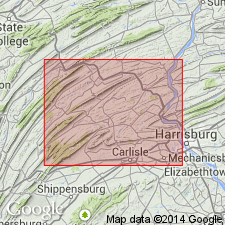
- Usage in publication:
-
- Buffalo Mountain paleosol
- Modifications:
-
- Named
- Dominant lithology:
-
- Paleosol
- AAPG geologic province:
-
- Appalachian basin
Summary:
Buffalo Mountain paleosol is very representative of a typical paleosol in the Duncannon Member of the Catskill Formation. The Duncannon exhibits repeated stacking of 5- to 10-m thick fining-upward sequences that consist of erosive-based, non-red, cross-stratified, medium- to coarse-grained channel sandstone; red-brown, ripple cross-laminated to parallel-laminated, very fine- to fine-grained sandstone; red-gray silty claystone, commonly with paleosol features. The 5-m thickness of the paleosol interval suggests that it probably is composed of several different paleosols, formed by repeated episodes of floodplain aggradation alternating with pedogenesis. Rhizoliths and calcareous nodules occur just above the laminated siltstone at the base of the Buffalo Mountain, indicating rooting during early stages of soil formation. Above the nodules are 3 m of clayshale, characterized by pedogenic slickensides. Age of the Duncannon and its Buffalo Mountain paleosol is Late Devonian.
Source: GNU records (USGS DDS-6; Reston GNULEX).
For more information, please contact Nancy Stamm, Geologic Names Committee Secretary.
Asterisk (*) indicates published by U.S. Geological Survey authors.
"No current usage" (†) implies that a name has been abandoned or has fallen into disuse. Former usage and, if known, replacement name given in parentheses ( ).
Slash (/) indicates name conflicts with nomenclatural guidelines (CSN, 1933; ACSN, 1961, 1970; NACSN, 1983, 2005, 2021). May be explained within brackets ([ ]).

